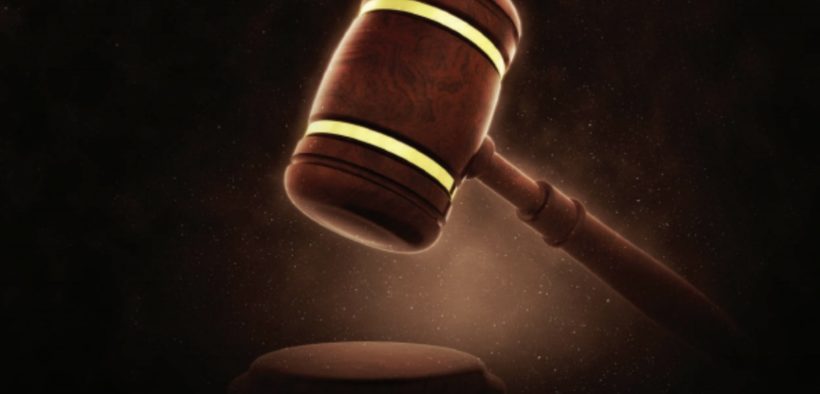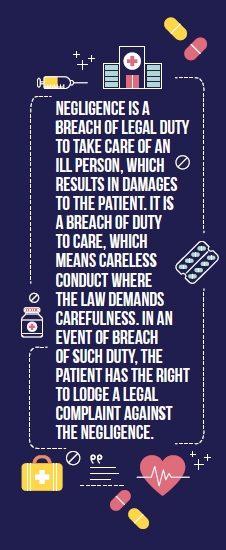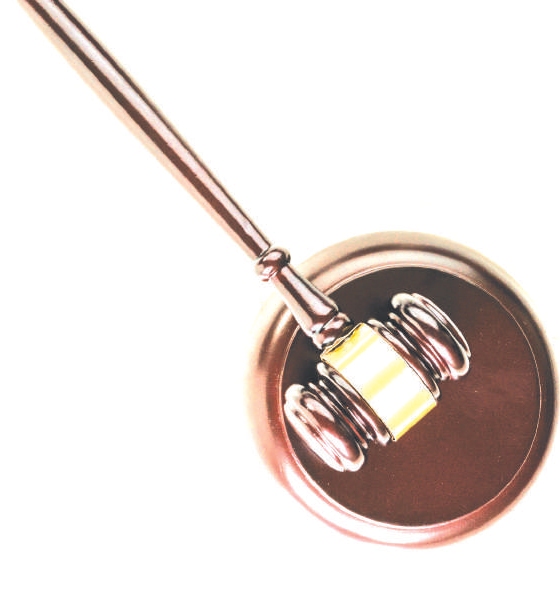Doctors In The Dock

The number of medical negligence claims has steeply increased since the inclusion of the medical profession under the purview of Consumer Protection Act 1986 in India in 1996. As the claims continue to grow, the crucial questions are—how unmarred the virtuous doctor-patient relationship remains and how robust our healthcare system is
By Aatika H Jain
Recently, a husband won in his decade-old fight against a Delhi hospital for medical negligence. He had lost his wife to medical complications. The Delhi State Consumer Redressal Commission found G M Modi Hospital not only guilty of negligence but also observed that ‘unnecessary’ surgeries were performed to increase the bill. The hospital was slapped with a fine of INR 21 lakh. Medical negligence claims have been piling up across India. Thousands of patients die in the country due to negligence every year. According to a report by the National Accreditation Board for Hospitals, 98,000 deaths happen due to medical injuries every year in India. As per Manupatra, a legal online research service, medico-legal cases have increased by 400 percent in the apex court in the last 10 years.

A few months ago, at a Delhi government-run critical trauma center, a doctor mistakenly operated on the leg of a patient admitted with a head injury. The senior resident was barred from performing surgeries without supervision after a hospital panel found him guilty of negligence. In another case, a senior AIIMS doctor purportedly carried out a dialysis treatment procedure on a 30-year-old woman complaining of abdominal pain. Of late, cases of such medical negligence have been consistently coming to light. It raises the apprehension that our healthcare sector needs overhauling and where this leaves the implicit faith an average Indian patient reposes in the doctors, considered akin to God.
Medical negligence and the law
In addition to knowledge and expertise, the medical profession calls for a touch of humanity, unlike other common professions. People depend on doctors and hospitals to cure their illnesses or injuries. Medical treatments innately involve the risk that something might go wrong. Apart from this, different patients react differently to the same procedure. This makes medical negligence a complex subject. In many instances, patients suffer an injury due to some treatment, or lack of it or delay in its administration. Occasionally, doctors and hospital staff also commit mistakes, which can adversely affect patients.
Lord Clyde, in Hunter vs Hanley, presented a very succinct definition for medical negligence saying: “The true test for establishing negligence in diagnosis or treatment on the part of a doctor is whether he has been proved to be guilty of such failure as no doctor of ordinary skill would be guilty of if acting with ordinary care.”
What the law says
The Indian legal system deals with medical negligence cases majorly through consumer forums under civil law. In 1996, the Supreme Court brought medical services under the ambit of the Consumer Protection Act (CPA), 1986 (Indian Medical Association vs Shantha and Others, 1996). Therefore, the medical treatment given by doctors became subject to the laws pertaining to other service providers. Still, the standard of care from doctors and hospital authority is expected to be more in comparison with other cases of negligence, says Aashutosh Srivastava, an SC lawyer. Opines Dr. Madhuchanda Kar, Advisory Council Member, Dept of Health, West Bengal, and a committee member of the Indian Medical Association: “The Act is actually against the interests of patients because this has ultimately led to defensive medical care. But I strongly feel that it is also necessary that all doctors regulate themselves through adherence to principles of medical ethics.”
This CPA inclusion increased the chances of dispute settlement through awarding compensation; this practice is beset by several issues. The compensation calculation is subjective to the adjudicating panel and varies from case to case. Judges find it difficult to ascertain the degree of medical negligence as they are not trained in the field. Judges must rely on a panel of industry specialists to offer their opinions on whether negligence occurred, states Srivastava. “Many illnesses and injuries have multiple treatment methods, and experts often disagree on what is the best course of action,” he adds. This makes medical negligence cases more unpredictable than other liability cases. “Consumer courts are not equipped or competent to judge intricate medical matters involved in such litigations,” says Dr Kar. “So this implies there is the possibility and wide scope of injustice mainly to the doctor, but maybe even to the litigant. Further, if the complaint is frivolous, then the complainant should also be fined. This will prevent unnecessary harassment of doctors.”
In the Shantha case, the SC held that the burden of proof is with the complainant to establish medical negligence on the doctor’s part. Mere allegations will not hold ground in the court. Doctors have no liability if they don’t charge a fee; that means free treatment at any medical facility will not be considered a service as defined in Section 2(1) (0) of CPA. In such cases, the patients can alternatively take to the law of torts for negligence and claim compensation. Often, doctors are implicated in criminal charges when a patient under treatment dies, allegedly due to negligence. In the case of Dr. Suresh Gupta vs Govt of NCT Delhi (2004), the bench stated that extreme care and caution should be exercised while initiating criminal proceedings against medical practitioners for alleged medical negligence. The court held that simple lack of care, the error of judgment, or an accident is not proof of negligence on the part of a medical professional and that failure to use special or extraordinary precautions that might have prevented a particular incidence cannot be the standard for judging alleged medical negligence.
Criminal negligence, according to Section 304A of the Indian Penal Code of 1860, states that ‘whoever causes the death of a person by a rash or negligent act not amounting to culpable homicide shall be punished with imprisonment for a term of two years, or with a fine, or with both’. For negligence to be a criminal offense, there should exist an element of men’s rea (intention or knowledge of wrongdoing) and there should be a gross and very high degree of negligence. ‘Simple lack of care’ entails only civil liability. Any conduct falling short of recklessness and deliberate wrongdoing should not be the subject of criminal liability, says Srivastava.
In India, the Bolam’s test is used to judge medical negligence of the doctor; this states that ‘if a doctor reaches the standard of a responsible body of medical opinion, he is not negligent’. Negligence is a breach of a legal duty to take care of an ill person, which results in damages to the patient. It is a breach of duty to care, which means careless conduct where the law demands carefulness. In an event of a breach of such duty, the patient has the right to lodge a legal complaint against the negligence. To prove medical negligence, the complainant must establish in the court beyond doubt that the doctor owed a professional duty of care towards the patient, that there was a breach of such duty, that the patient suffered injuries, and that the doctor’s negligence was the proximate cause of the injuries.“These cases are a complex area of liability law, and successful claims must meet a high threshold of proof to satisfy a judge,” explains Srivastava.
A medical negligence complaint can be filed in the district forum (if indemnity claim is less than INR 20 lakh), before the State Commission (if the claim is up to INR 1 crore), or before the National Commission (if the claim is more than INR 1 crore). The decision of the district forum can be appealed within 30 days before the State Commission and it can be escalated similarly to the National Commission and the SC respectively. The SC has held that it is the duty of a doctor to “bring to his task a reasonable degree skill and knowledge” and to exercise “a reasonable degree of care” (Laxman vs Trimbach, SC 1969). So the doctor doesn’t have to rise to the highest or sink to the lowest level of competence. The doctor doesn’t have to guarantee that every patient he attends is cured. He only has to conduct with a reasonable degree of care and skill which an “ordinary competent member of the profession who professes to have those skills would exercise in the circumstance in question”. The standard of care remains constant in all situations while the degree of care varies depending on the situation. For example, the standard of care shall remain the same in the case of a general physician and a specialist but the degree of care will differ depending upon their competence. The error of judgment doesn’t inevitably imply negligence.

The Indian Legal System Deals With Medical Negligence Cases Majorly Through Consumer Forums Under Civil Law. In 1996, The Supreme Court Brought Medical Services Under The Ambit Of The Consumer Protection Act (Cpa), 1986 (Indian Medical Association Vs Shantha And Others, 1996).
Aashutosh Srivastava
Lawyer who practises at the Supreme Court
Duty of care and patient’s consent
The doctor is legally bound to obtain the patient’s informed consent before any surgical procedures or in some cases, before the commencement of treatment. Treatment without informed consent can be equal to negligence. Every patient has the right to refuse treatment even if it would appear imprudent to rational standards. Doctors cannot enforce their will but can act on substituted consent in case the patient is minor, mentally unsound or unconscious. “Between 60-66 percent of the filed cases today are because of hospitals taking improper consent from relatives before performing certain procedures or switching hospitals or improper documentation throughout the course of diagnosis and treatment,” says Srivastava.
Liability of hospitals
In the case of medical negligence, the hospital’s liability can be direct or vicarious. Direct liability refers to want in the hospital services, thus making it risky and unsuitable for treatment while vicarious liability is its liability as an employer for the negligent conduct of its employees as long as the negligence occurs in the course of the employment. But if the employee says, a surgeon visits another facility for some operation, the other facility would be liable for the surgeon’s conduct during that surgery. It was held in the case of Smt. Rekha Gupta v. Bombay Hospital Trust and Anr. (2003) by the National Consumer Disputes Redressal Commission that hospital is responsible not only for the infrastructure it provides but also for visiting doctors, anesthetists or independently practicing doctors who admit or operate a case in the hospital.
MTP (Amendment) Bill 2016/Pre- conception and pre-natal diagnostic technique act (PC-PNDT)
The 1971 Medical Termination Pregnancy Act allowed abortions under a broad range of circumstances but left the women seeking abortion dependent on the healthcare professional instead of having the last say. The MTP (Amendment) Bill 2016 drafted by the Ministry of Health and Family Welfare contains amendments which focus on “improving the scope of legal access to MTP for special category of women which includes survivors of rape, victims of incest, single women (unmarried/divorced/widowed to be established on the basis of self-certification of woman), and other vulnerable women (differently-abled women). The upper gestational limit for termination of pregnancy for survivors of rape has been proposed to be increased from 20 weeks to 24 weeks. For pregnancies diagnosed with substantial fetal abnormalities, it has been proposed, that no upper gestation limit would apply for termination.”
PC-PDNT was enacted to regulate the use of prenatal diagnostic techniques to detect genetic or metabolic disorders, chromosomal abnormalities, or certain congenital malformations or sex-linked disorders. It also aimed to prevent misuse of these techniques for pre-natal sex determination leading to female foeticide. An amendment in 2003 also bans the advertisements of such services. Prominent display of signboards declaring fetal sex determination illegal was also made mandatory in all ultrasonography centers. A subdivisional judicial magistrate in Haryana sentenced a doctor and his assistant to two years’ imprisonment and a fine of INR 5000 each for violating the PC-PDNT in the first conviction for fetal sex determination in 2006. Despite a ban on sex selection and determination, India’s child sex ratio (0-6 years) has been steadily declining, from 945 girls/1,000 boys in 1991 to 927 in 2001 and 919 in 2011, reveals census data.

“The Act Is Actually Against The Interests Of Patients Because This Has Ultimately Led To Defensive Medical Care. But I Strongly Feel That It Is Also Necessary That All Doctors Regulate Themselves Through Adherence To Principles Of Medical Ethics.”
Dr Madhuchanda Kar
Advisory Council Member, Dept of Health,West Bengal
Medico-legal cases
More than 150, 000 deaths occur due to road accidents in the country; around 400 deaths in a day. The 201st report of the Law Commission of India states that at least 50 percent of road accident fatalities can be prevented if the victim is given ‘emergency medical care’ within the first hour of the accident, the purpose of which is to ‘stabilize’ the victim. Every third woman has faced domestic violence in different forms since the age of 15 in India, reports the National Family Health Survey released by the Union Health Ministry. In the face of such critical statistics, it is imperative that law agencies and hospitals work in tandem to help the victims.
Medico-legal cases (MLC) are where a person is injured in such a way that s/ he needs medical care. Injuries in such cases imply criminal offenses such as vehicular accidents, including all modes of transport, poisoning, burn injuries, suspected homicide, sexual assault, and criminal abortion. Patients brought unconscious because of unknown reasons, brought dead or die soon after admission without any suitable medical documents specifying the reason for death also makes for MLC.
Hospital deaths such as sudden death after the administration of a medicine or during surgery or in ICU or due to a fall in the hospital can all be considered as MLC. A medical autopsy is mandatory in all such cases. MLCs are generally considered undesirable by the victims and their families as well as the doctors attending to them. This jaundiced view is mainly due to the prevalent misconception that MLCs entail harassment at the hands of law enforcement agencies, long-drawn judiciary procedures, and a dismal judgment rate. The ruling by the SC in the landmark case of Paramanand Katara vs. Union of India in 1989 laid down the decisive guidelines which ensured every citizen’s right to immediate medical aid. There is a crucial need for spreading awareness about the laws and guidelines which protect the victims as well as the doctors. Some important points that everybody should be aware of are:
Under Article 21, a hospital (including government/ private hospitals, private clinics, and nursing homes) cannot refuse emergency medical treatment to an accident victim. Lack of facilities is an invalid reason for denying emergency treatment, which it has to mandatorily provide to the victim and then transfer the victim in their ambulance to the nearest medical facility. The hospital cannot refuse emergency treatment to a patient due to the inability to pay the required fees or absence of any close relative for consent. Consent is overridden in case of an emergency.
Every doctor has the professional obligation to extend his/her services with due expertise for protecting life. There is no legal impediment for a medical professional when he or she is called upon or requested to attend to an injured person needing his or her medical assistance immediately. There is also no doubt that the effort to save the person should be the top priority not only of the medical professional but even of the police or any other citizen who happens to be connected with the matter or who happens to notice such an incident or a situation.
Lawyers and judges and everyone concerned should also keep in mind that a person in the medical profession should not be unnecessarily harassed for purposes of interrogation or for any other formality and should not be dragged during investigations at the police station. This should be avoided as far as possible. In cases of sexual assault or criminal abortion, the doctor cannot examine the patient without the patient’s written consent. The examination of a woman can only be done in the presence of another woman. In the case of men, another man must be present during the examination. In both the cases of sexual assault or criminal abortion, the doctor is bound by the law to keep the patient’s details, including the name, confidential. In cases of suicide resulting in death, the doctor is duty-bound to report it to the police. But if the patient is alive in case of a suspected suicide, the doctor is not duty-bound to report it to the police.
Once the doctor has administered primary emergency care, it is his legal duty to report the matter to the nearest police station according to Section 39 of the Criminal Procedure Code. This helps in starting legal proceedings at the earliest so those police officers can gather most evidence and prevent evidence damage during medical treatment. A docket number or an acknowledgment receipt is provided by the police that is documented in the patient’s file for further reference.
In 2016, the SC approved the Good Samaritans protection guidelines, which provide legal protection to people who offer help to those who are or who they believe to be wounded, sick, in danger, or incapacitated in some way. A Good Samaritan calling the police about some accident need not disclose his/her personal details. The decision to become a witness in the case is entirely up to his/her sole discretion. If they do agree to become a witness, they will be interrogated at the time and place of their choice. The Good Samaritan shall not be subject to any civil or criminal liability. It will be amount to ‘professional misconduct’ if a doctor denies medical care in case of an emergency.
Also read about
Recently, the Lucknow Bench of Allahabad Court fined three doctors for writing illegible medico-legal reports. The Bench observed that “the medico-legal report if given clearly, can either endorse the incident as given by the eyewitnesses or can disprove the incident to a great extent. This is only possible if a detailed and clear medico-legal report is furnished by the doctors, with complete responsibility. The medical reports, however, are written in such shabby handwriting that they are not readable and decipherable by advocates or Judges.” It has directed the submission of computerized reports along with original handwritten ones to aid the courts. “These computer-printed versions of medico-legal reports/injury reports and post mortem reports would neither be a substitute of the original one nor would be taken as a supplement, however, they would facilitate not only the courts but also the counsel for the prosecution and the defence to clearly understand their contents and accordingly assist the court,” it added.
Finding the middle ground
India has seen steadily increasing awareness about the rights of patients in the past few decades and this is evident by the growing litigation cases against medical professionals and institutions. The rising litigation cases against doctors have also affected the doctor-patient relationship. “Doctors are getting very cautious in taking up risky surgery or emergency procedures and many have already stopped admitting high-risk and very ill patients under their care to avoid such litigations,” says Dr. Kar. “The relationship of patients now is no longer with the doctor alone but with the system of care. This has suffered from the diffusion of responsibility. What was a bipartite relationship between doctor and patient has become a complicated tripartite relationship.”

The Indian health care sector has seen large private investment in contrast to decreasing state expenditure in the sector; there is a massive lack of human resources and the immense difference between urban and rural health care facilities. In addition, the political will to improve the healthcare sector seems to be sorely lacking. In the light of these conditions, the protection of patients’ rights becomes more significant given how SC has painstakingly been trying to constitutionalize the right to health as a fundamental right. However, it is essential to strike a careful balance between the protection of patients’ rights and maintaining professional autonomy and veracity.
Presently, the consumer forums or the civil or criminal court applies the common laws related to indemnity claims for negligence, impaired consent, and confidentiality violations. There is a need for identifying reasonable basic standards in the existing economic, social, and cultural framework. This will help the judiciary to objectively adjudicate the legal liability of medical negligence. This standard recognition will also help healthcare professionals incorporate it in their regular practice, which would, in turn, check instances of medical negligence. A nofault liability system can also be implemented in the public health sector and impose caps after reasonable deliberation. Indian doctors can also opt for Professional Liability or Indemnity Insurance, which covers the patient injury resulting from medical negligence. The malpractice insurance spreads the risk and safeguards the doctor from financial losses. This saves the doctor from undue worry over the risk of medical negligence litigation.
Possessing the fundamental knowledge about the process of adjudication of medical negligence liability in various Indian courts will help the doctors practice their profession without any unnecessary concern over facing litigation for alleged medical negligence. “In view of the trying circumstances that doctors are in at present and the pressing medico legal laws, at least two experts in the respective fields need to testify any given complaint before accepting for legal discourse,” suggests Dr. Kar. “Capping of compensation is something that is urgently demanded by the doctors.” With some positive bilateral changes, in time, the existing oppositional position of patient and doctor will transform and benefit the society in general.
Cases across countries
Medical negligence claims have been on a rise in most countries while in some, they are rarely brought to the light. In such countries, their medical associations need to be vigilant against such issues and situations to protect the rights of the patients.
Medical negligence claims are pretty common in the US. The medical negligence law is drawn from English common law. It evolved through different rulings in the state courts. The US follows tort (literal meaning, wrongs) liability system, “social insurance of a market society”, wherein the patients are monetarily compensated when it is established that medical negligence has led to the patient’s injury. The medical negligence claims come under the purview of state courts instead of the federal, unlike in many countries. The judiciary system is built in a way to encourage negotiations between the two involved parties to settle the dispute without going to the jury trial. Allegations must be filed within a time period called “statute of limitation” and this differs for different states. The complainant has to prove that substandard medical care has led to injury to the patient and once proven, monetary compensation is calculated taking into account both financial losses, hits in terms of loss of job and medical costs incurred, and non-financial losses, such as distress and pain. Doctors practicing in the US generally have medical malpractice insurance to safeguard themselves in case of unintentional damages or medical negligence.
In many cases, it is a part of the employment contract with a medical institution. Due to the increasing claims of medical negligence, US states have put caps on the total compensation given or on non-financial losses, or constraints on compensation depending on whether the hospital, where the substandard care was provided, is private or public. Various US states have also introduced apology and mandatory disclosure legislations to grant the complainants with alternative options. These legislations encourage doctors to accept their mistake and offer an apology as long as it isn’t taken as legal liability in court. But it has little effect as the scope of the definition of apology in these legislations is very narrow. These tort reforms aim to emphasize the requirement of more transparency in the health sector.
In the UK, medical negligence claims are adjudicated by its courts and most of the doctors are insured by the National Health Services (NHS), which deals with the legal aspects of medicine.NHS doctors aren’t liable for medical negligence claims and thus, don’t carry any medical malpractice insurance. NHS insurance funds come from government funds. Jury trials are rare in the UK but otherwise, medical negligence claims follow the same legal path as that in the US. The tort liability is said to be unfair, incompetent and expensive for both the patient and the healthcare professionals and institutions. No-fault liability has been introduced as its alternative and has been implemented in countries like Sweden and New Zealand, which are members of OECD (Organisation for Economic Co-operation and Development; a group of 36 nations).
Due to the increasing claims of medical negligence, US states have put caps on the total compensation given or on non-financial losses, or constraints on compensation depending on whether the hospital, where the substandard care was provided, is private or public.
It is a system of “social insurance of goodwill” wherein the patients are compensated without the proof of the care-provider’s mistake. Minimum, fixed monetary support is given, without any conditions, to the patient alleging medical negligence, which has resulted in permanent disability or death, when a case comes for a trial to any court before any merit of the allegations is established. Though the system is less expensive and more competent in giving compensation to the patients, it constrains the right to appeal for the patient. In France, patients can appeal to the regional review board appointed by the government for their medical negligence claim. In this no-fault liability, out-of-court system, the funds for compensation are contributed either by the national fund (collected from the insurance carried by doctors and hospitals) or general revenue fund. In Germany, arbitration boards and experts panel made by the doctors’ guild hear the medical negligence claims. The results can be rejected by the patients who then take it to the court similar to the US.
In Sweden, Finland, Denmark, and Norway, similar out-of-court, no-fault liability system provides compensation for the patients of medical negligence due to inevitable risks of medical care. They also get compensated for injuries due to faulty equipment, equipment misuse, flawed diagnoses and any infection caught during the course of the treatment. In Japan, most of the doctors are members of the Japan Medical Association. The no-fault liability compensations are funded by the collective insurance pool of the association. Private malpractice insurance is also available but not mandatory. Permanent disability or death of the patient due to medical fault is considered a criminal offense in Japan, unlike the US, with the likelihood of the arrest and prosecution of the doctor. Canada has a similar legal system for medical negligence but such cases have gradually decreased since 1997 due to better patient safety measures and doctors’ regular professional development initiatives. Australia also has a similar medical negligence address system as that of Canada but have concerns similar to America regarding increasing claims and caps on them.

Landmark medico-legal cases in India
The Indian legal system deals with medico-legal cases primarily through its consumer courts. The introduction of the Consumer Protection Act in 1986 has helped Indian patients to address their grievances about medical negligence by health care professionals.
Laxman B. Joshi v. T. B. Godbole and Another (AIR 1969 SC 128)
The standard of care was laid down by the Supreme Court in these cases. The SC held that if a doctor has taken steps that are an acceptable practice considered “proper” by a reasonable body of medical experts in that field, s/he will not be liable to negligence just because something went wrong.
Parmanand Kataria v. Union of India (AIR 1989 SC 2039)
The SC explained that the duty of a doctor towards his patient is to “bring to his task a reasonable degree of skill and knowledge” and to exercise “a reasonable degree of care”.
Paschim Bengal Khet Mazdoor Samity and Ors. v. State of Bengal(1996(4)SC260)
Hospitals are liable for negligence for not providing adequate medical facilities.
The state of Haryana v. Smt Santra (AIR 2000 SC 3335)
The SC held that every doctor “has a duty t2o act with a reasonable degree of care and skill”.
Aparna Dutt v. Apollo Hospital Enterprises Ltd (2002 ACJ 954 (Mad. HC)
It was established that if any of the hospital staff falls short in their assigned duty, the hospital will be held liable to negligence, even in cases of borrowed doctors for certain surgeries.
M Ramesh Reddy v. State of Andra Pradesh [2003 (1) CLD 81 (APSCDRC)
Hospitals are vicariously liable for negligence if they don’t provide proper sanitation facilities.
Pravat Kumar Mukherjee v. Ruby General Hospital and Ors (2005 CPJ 35 (NC)
In this case, the hospital was held liable for negligence when the accident victim died en route to another hospital when the first hospital approached refused treatment. The complainant was awarded compensation of INR 10 lakh on humanitarian grounds.

Marrin F D’Souza v. Mohd Ishfaq (2 SC 40, 2009)
The SC observed that medical caregivers shouldn’t be overly worried about how they perform. The law is only vigilant and as long as they do their duty with reasonable care, they won’t be liable for negligence even if their course of treatment fails.
Kusum Sharma v. Batra Hospital and Medical research Center and Other (AIR 2010 SC 1050)
The SC held that if the medical professional falls below the level of standard reasonable competence in the said field, s/he will be liable for negligence due to deficiency in medical service according to section 2(1)(g) of Consumer Protection Act.
















